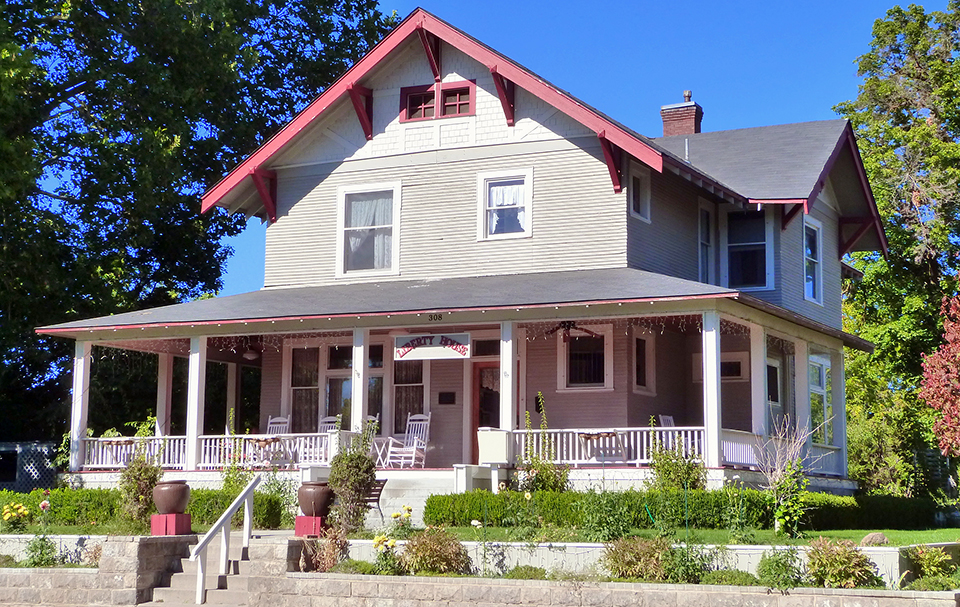Weiser City
Weiser City Hall is located at 55 West Idaho Street, Weiser, ID 83672.
Phone: 208-414-1965.

Photo: G. V. Nesbit House, circa 1909, located at 308 West Liberty Street in Weiser. Listed on the National Register of Historic Places in 1982. Photographed by User:Ian Poellet (own work), 2015 [cc-4.0 ], via Wikimedia Commons, accessed March, 2023.
Neighborhoods
- Galloway
- Link Bar Hills
- Quail Run
- Quails Nest
- River Bend
- Rolling Hills
- Striker Ranch
- Sunnyside
- Trotts Addition
- Valley View
- Watlingtons Add
- Whiting
History [†]
The Weiser River Valley is located near the route of the Oregon Tail, and attracted Euro-American settlement by 1863. That year Rueben Olds built a ferry across the Snake River west of the Weiser Valley near Farewell Bend, and William and Nancy Logan of Baker City, Oregon, established the first way station for travelers on the north side of the Snake River. Thomas Galloway, an Oregon Trail emigrant and miner, homesteaded near the confluence of the Snake and Weiser rivers in 1864. Galloway and others built the first bridge across the Weiser River in 1865. By the 1870s, the settlement was known as "Weiser Bridge."
Mining activity stimulated the development of agriculture and ranching in the Weiser valley. Weiser became a supply hub during southern Idaho's mining boom, supporting the development of mines in the Boise Basin to the east, the Owyhee Mountains to the southwest, and placer mines located along the Snake River and its tributaries. Water supply was an issue that needed to be resolved to increase agricultural production. In 1880, a group of settlers formed the Weiser Canal and Irrigation Company, with the intention of developing a canal system to draw water from the Weiser River to irrigate farmlands. The first attempts failed and in 1883, a new entity the Weiser Water Company, constructed a ditch extending from the Snake River. In 1885 the ditch was purchased by Thomas Galloway and several investors, who improved and maintained the system for almost 20 years before selling it to the Weiser Irrigation District in 1902. Over time, the Galloway Ditch and other irrigation developments transformed the sagebrush flats west of Weiser to croplands and orchards, and Weiser became one of the major farming communities in southwest Idaho.
The land around Weiser also had good range grasses for cattle and sheep. By the end of the nineteenth century, the Weiser area was known as sheep country. An estimated 130,000 sheep were in the area in 1900. Many sheep ranchers built houses in Weiser. The sheep industry lent stability to the local economy for several years.
The construction of the Oregon Short Line railroad across southern Idaho in the 1880s also contributed to Weiser's growth, tying the community to larger regional transportation and supply networks. A wood frame railroad depot was constructed in 1886 near the west edge of town. In 1899 the Pacific and Idaho Northern railroad constructed a rail line to Weiser.
In May of 1890, a fire destroyed much of Weiser's business district. Reconstruction after the fire occurred west of the original location. Before much rebuilding occurred, Weiser suffered major economic setbacks with the national Panic of 1893 when, as in many other communities, it experienced a bank failure. It was several years before the local economy recovered, but as things stabilized after the turn of the century, Weiser again began to grow The population, which stood at 700 in 1886, grew to approximately 3,500 by 1910.
† Adapted from: Barbara Perry Bauer & Elizabeth Jacox, Historical Research&Consulting, Institute Canal Pump House. nomination document. 2015, National Register of Historic Places, Washington, D.C.
